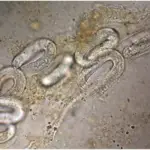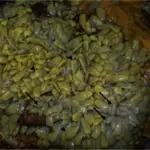Trichinosis Infection is a food-borne disease caused by a microscopic parasite called Trichinella.
What is the Pathology of Trichinosis Infection?
The pathology of trichinosis infection is:
-Etiology: The cause of trichinosis infection is the larvae of the Trichinella roundworm.
-Genes involved: Not applicable.
-Pathogenesis: The sequence of events that lead to trichinosis infection are: the infection due to eating raw, undercooked, or under-processed meat from infected animals, most commonly pigs, wild boar, or bear. Larvae cysts enter the small bowel, then penetrate the mucosa, and then become adults in 6 to 8 days causing infection.
-Morphology: The morphology associated with trichinosis infection shows measurements between 1.4 and 1.6 mm long, and are more flat anteriorly than posteriorly. The anus can be found in the terminal end, and they have a large copulatory pseudobursa on each side.
-Histology: The histology associated with trichinosis infection shows mucosa in the vicinity of embedded worms is edematous and friable with increased histiocytes within the lamina propria.
How does Trichinosis Infection Present?
Patients with trichinosis infection typically in all genders and at all ages, but mostly at 20-49 years age. The symptoms, features, and clinical findings associated with trichinosis infection include: diarrhea, nausea, fatigue, stomach pain, fever, headaches, chills, muscle soreness, pain and swelling around the eyes.
How is Trichinosis Infection Diagnosed?
Trichinosis infection is diagnosed by blood samples tests for white blood cells level, muscles biopsy, and ELISA test.
How is Trichinosis Infection Treated?
Trichinosis infection is treated by antiparasitic medicines: albendazole, mebendazole.
What is the Prognosis of Trichinosis Infection?
The prognosis of trichinosis infection is good. Trichinosis usually isn’t serious and often gets better on its own, usually within a few months.



